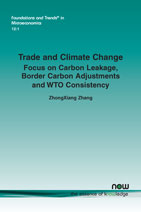Trade and Climate Change: Focus on Carbon Leakage, Border Carbon Adjustments and WTO Consistency
By ZhongXiang Zhang, Tianjin University, China, ZhangZX@tju.edu.cn
Abstract
This monograph provides a comprehensive review of the literature on competitiveness and leakage concerns associated with differentiated climate abatement commitments among countries. The literature reviewed is not exhausted, but it is sufficient to provide a balanced view of both academics and policy circles. Section 2 discusses main channels of carbon leakage. Section 3 discusses how to identify the sectors at a risk of carbon leakage. Section 4 examines ex ante estimates of potential carbon leakage rates, and explains why they differ from ex post results of environmental tax reforms and greenhouse gas emissions trading schemes that have been implemented in the European Union. Section 5 discusses broad policy options to address competitiveness and leakage concerns, and compares which anti-leakage policy, border adjustments or output-based allocation, is more effective to limiting carbon leakages or mitigating production loss in the sectors affected. Given that border carbon adjustment measures were incorporated in the U.S. proposed congressional climate bills to level the carbon playing field and could have potential conflicts with World Trade Organization (WTO) provisions and practical difficulties associated with their implementation, Section 6 discuses in great detail the WTO consistency, the effectiveness and methodological challenges of border carbon adjustment measures. The monograph ends with some concluding remarks.
Trade and Climate Change: Focus on Carbon Leakage, Border Carbon Adjustments and WTO Consistency
Trade and Climate Change: Focus on Carbon Leakage, Border Carbon Adjustments and WTO Consistency reviews the literature on competitiveness and leakage concerns associated with differentiated climate abatement commitments among countries. Section 2 discusses main channels of carbon leakage. Section 3 discusses how to identify the sectors at a risk of carbon leakage. Section 4 examines ex ante estimates of potential carbon leakage rates, and explains why ex ante estimates differ from ex post results of environmental tax reforms and greenhouse gas emissions trading schemes that have been implemented in the EU. Section 5 discusses broad policy options to address competitiveness and leakage concerns, and compares which anti-leakage policy, border adjustments or output-based allocation, is more effective to limiting carbon leakages or mitigating production loss in the sectors affected. Given that border carbon adjustment measures were incorporated in the U.S. proposed congressional climate bills to level the carbon playing field and could have potential conflicts with the World Trade Organization (WTO) provisions and practical difficulties associated with their implementation, Section 6 discuses in great detail the WTO consistency, the effectiveness and methodological challenges of border carbon adjustment measures. The monograph ends with some concluding remarks.
